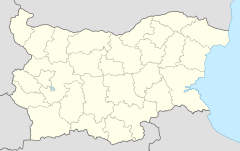Ruse Central railway station
Ruse Central | |||||
|---|---|---|---|---|---|
 | |||||
| General information | |||||
| Location | 1 Aleksandar Stamboliyski Sq. Ruse, Bulgaria | ||||
| Coordinates | 43°49′58″N 25°57′18″E / 43.83278°N 25.95500°E | ||||
| Owned by | NRIC | ||||
| Platforms | 3 | ||||
| Tracks | 4 | ||||
| Construction | |||||
| Structure type | At-grade | ||||
| Platform levels | 2 | ||||
| Parking | Yes | ||||
| History | |||||
| Opened | 1955 | ||||
| Electrified | 1963 | ||||
| |||||
Ruse Central railway station is the main station serving the city and municipality of Ruse, the fifth most populous city in Bulgaria. It is next to the Danube River.
It was the first station built in what is now Bulgaria, in 1866. It was the end of the Ruse - Varna railway. In 1966, the National Museum of Transport and Communications was opened in the former Ruse-East railway station , and the tracks were used for the outdoor exhibition.
After the opening of the Danube Bridge in 1954, a new grand Stalinist Central Railway Station was planned for the city of Ruse. The new station opened in late 1955. It is the biggest on the Balkan peninsula. It has three platforms, with four tracks and one passing track. [1]


It is a transport hub, with trains to Gorna Oryahovitsa (mostly), to Sofia, Varna, Samuil, and Burgas seasonally, as well as Bucharest and Istanbul internationally. The station serves as a border checkpoint for trains crossing into Romania by the Danube Bridge.

